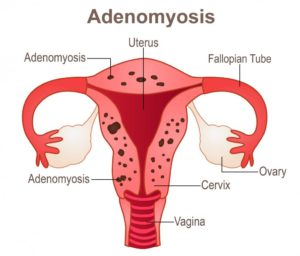If you’ve got longer-than-usual menstrual bleeding, as well as pain during your menstrual cycle or intercourse, you could have adenomyosis – a condition of the uterus (womb) that affects approximately 1 in 10 Australians assigned female at birth.
A number of our gynaecologists take a special interest in the diagnosis and treatment of adenomyosis and endometriosis. Read on to learn more about adenomyosis then get in touch to book an appointment with one of our specialist gynaecologists.
What is adenomyosis?
Adenomyosis is a disorder in which endometrial glands and stroma (cells and tissues similar to the lining on the inside of the uterus) are present within the myometrium (uterine muscle layer). The term comes from the words: adeno (gland), myo (muscle) and osis (condition). It is pronounced: ad-uh-no-my-O-sis.
Women with adenomyosis often have endometriosis, in fact adenomyosis is often referred to as ‘endo’s ugly twin sister’. Although they are different conditions, both involve ectopic (abnormal) placement of endometrial type tissue – adenomyosis into the uterine muscle layer and endometriosis outside of the uterus.

What causes adenomyosis?
While there is no known cause of adenomyosis, there are two main theories:
- It results from stem cells being abnormally present in the uterine wall.
- It is caused by the invasive growth of abnormal tissues.
What are the risk factors?
Not enough is known about adenomyosis to clearly identify risk factors. However, there are some factors that have an association with adenomyosis. You may be at greater risk if you’ve had children, are older, have other gynaecological conditions such as endometriosis or if you’ve had uterine surgery such as a caesarean delivery or surgery to remove fibroids.
There is still so much we don’t know about adenomyosis and endometriosis and there is a pressing need for more research into these mysterious and enigmatic conditions.
What are the symptoms of adenomyosis?
Symptoms of adenomyosis can be mild to severe. Some people may not even experience any symptoms. The most common ones include:
- Spotting (bleeding) between periods
- Heavy menstrual bleeding
- Prolonged menstrual cramps
- Longer than normal menstrual cycles
- Blood clots when menstruating
- Pain during sex
- Abdominal tenderness
- Difficulty falling pregnant
Adenomyosis and fertility
Adenomyosis can affect fertility in some people. Women in their 30s and 40s with adenomyosis may have fewer spontaneous and successful assisted pregnancies. This is because normal sperm movement and embryo implantation into the uterine lining can be affected. The risk of miscarriage may also be higher if adenomyosis if is present.
Adenomyosis can also interfere with the process of in vitro fertilization (IVF) by disrupting implantation. An increased myometrial (uterine muscle layer) thickness, thought to be due to a thickened junctional zone (a region representing the inner myometrium), is associated with IVF implantation failure. More research is needed to clarify the connection between implantation and changes to the junctional zone.
How is adenomyosis diagnosed?
Adenomyosis can be difficult to diagnose. A definitive diagnosis is based on a histopathological assessment of the uterus after a hysterectomy. However, a clinical diagnosis can be made based on history, physical examination and investigations – namely a transvaginal (internal) ultrasound scan or a pelvic MRI (magnetic resonance imaging) scan.
What are the treatment options?
Adenomyosis can be managed if diagnosed with the right healthcare team. Medical treatment isn’t usually required for mild symptoms, though if the condition interferes with your day-to-day life some treatment options include:
- Non-medical options such as exercise, meditation or acupuncture
- Antifibrinolytic medication to reduce heavy bleeding (e.g. tranexamic acid – Cyclokapron)
- Anti-inflammatory medications to reduce cramping (e.g. mefenamic acid (Ponstan) or ibuprofen (Nurofen))
- Hormonal treatments (including birth control pills, progestin-only contraceptives and intrauterine devices)
- Uterine artery embolization (a procedure to block the uterine arteries from supplying blood to the uterus)
- Hysterectomy (removal of the uterus)
Adenomyosis cannot normally be removed without a hysterectomy, but it can still be managed.
If you think you may be experiencing some of these symptoms, please ask your GP to consider referring you to an Eve Health gynaecologist for further assessment and investigation.
Further information on adenomyosis can be found at: Jean Hailes for Women’s Health; QENDO.
More information on endometriosis can be found here: Endometriosis.
Comments are closed.
